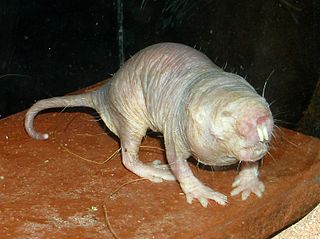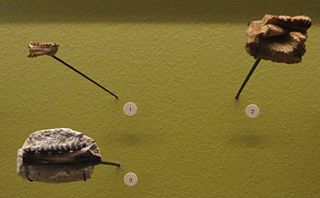
The family Aplodontiidae also known as Aplodontidae, Haplodontiidae or Haploodontini is traditionally classified as the sole extant family of the suborder Protrogomorpha. It may be the sister family of the Sciuridae. There are fossils from the Oligocene until Miocene in Asia, from Oligocene in Europe and from the Oligocene until the present in North America, where there is the only living species: the mountain beaver.

The rodent parvorder or infraorder Phiomorpha comprises several living and extinct families found wholly or largely in Africa. Along with Anomaluromorpha and perhaps the extinct Zegdoumyidae, it represents one of the few early colonizations of Africa by rodents.
Pseudoltinomys is a prehistoric rodent that lived approximately 30 million years ago, during the Oligocene epoch. It outwardly resembles a gerbil, but may have been related to kangaroo rats or may represent an early offshoot of rodents with no modern relatives.

Diatomyidae is a family of hystricomorph rodents. It is represented by a single living species, Laonastes aenigmamus, native to Laos in Southeast Asia. Fossil species are known from the Oligocene and Miocene of Asia and eastern Europe.
The zygomasseteric system in rodents is the anatomical arrangement of the masseter muscle of the jaw and the zygomatic arch of the skull. The anteroposterior or propalinal (front-to-back) motion of the rodent jaw is enabled by an extension of the zygomatic arch and the division of the masseter into a superficial, lateral and medial muscle. The four main types are described as protrogomorphous, sciuromorphous, hystricomorphous, and myomorphous.

Palaeotheriidae is an extinct family of herbivorous perissodactyl mammals that inhabited Europe, with less abundant remains also known from Asia, from the mid-Eocene to the early Oligocene. They are classified in Equoidea, along with the living family Equidae.
Corbarimys cezannei, formerly Pseudoparamys cezannei, is a species of extinct rodent in family Ischyromyidae. It is named after French Post-Impressionist painter Paul Cézanne.
This paleomammalogy list records new fossil mammal taxa that were described during the year 2012, as well as notes other significant paleomammalogy discoveries and events which occurred during that year.
Philisidae is an extinct family of bats of the suborder Microchiroptera that lived between the Eocene to the Late Miocene in the continent of Africa.
This paleomammalogy list records new fossil mammal taxa that were described during the year 2013, as well as notes other significant paleomammalogy discoveries and events which occurred during that year.

Cainotheriidae is an extinct family of artiodactyls known from the Late Eocene to Middle Miocene of Europe. They are mostly found preserved in karstic deposits.
The Quercy Phosphorites Formation is a geologic formation and lagerstätte in Occitanie, southern France. It preserves fossils dated to the Paleogene period, or MP16 to MP28 zones of the European land mammal age classification, ranging from approximately 38 to 25 Ma.

Necromantis is an extinct genus of bat that lived during the Eocene. Its fossils are found in the Quercy Phosphorites Formation of France and the Djebel Chambi in Tunisia. Specimens of Necromantis are notable for their large size and specialization towards a predatory lifestyle.

Dichodon is an extinct genus of Palaeogene artiodactyls belonging to the family Xiphodontidae. It was endemic to Western Europe and lived from the middle Eocene up to the earliest Oligocene. The genus was first erected by the British naturalist Richard Owen in 1848 based on dental remains from the fossil beds in Hordle, England. He noticed similar dentitions to contemporary artiodactyls like those of the Anoplotheriidae and Dichobunidae and references the name of the genus Dichobune. Eventually, it was found to be more closely related to Xiphodon and now includes 11 species, although one of them may be synonymous.
Haplomeryx is an extinct genus of Palaeogene artiodactyls belonging to the family Xiphodontidae. It was endemic to Western Europe and lived from the middle Eocene up to the earliest Oligocene. Haplomeryx was first established as a genus by the German naturalist Max Schlosser in 1886 based on a molar tooth set from Quercy Phosphorites deposits. Three additional species were erected and classified to the xiphodontid genus while one other species, first recognized in 1822, was tentatively classified to it and remains unresolved in affinity.

Equoidea is a superfamily of hippomorph perissodactyls containing the Equidae, Palaeotheriidae, and other basal equoids of unclear affinities, of which members of the genus Equus are the only extant species. The earliest fossil record of the Equoidea proves unclear, but they possibly could have originated during the late Paleocene in Europe or Asia. Definite fossil records of equoids are recorded by the earliest Eocene, in which the earliest equids in North America and basal equoids of unclear affinities in Europe both appeared. Palaeotheres are thought to have originated later in the early Eocene of Europe, although some researchers disagree on whether the subfamily Pachynolophinae belongs to the Palaeotheriidae.
Reinomys is an extinct genus of Palaeogene rodents of unclear affinities belonging to the infraorder Theridomorpha. The genus and its only known species Reinomys rhomboides were both named by the French palaeontologists Monique Vianey-Liaud and Laurent Marivaux in 2021 based on some lower molars from the French locality of Avenay that dates back to the later early Eocene. It is diagnosed as being similar in size to another basal rodent Sparnacomys but differing based on specific traits of the tooth surfaces and cusps.
Auroremys is an extinct genus of Palaeogene rodents belonging to the theridomorph family Pseudosciuridae. The type and only species Auroremys subita was first named by Bernard Comte et al. in 2012 as belonging to the ischyromyid genus Ailuravus before it was eventually reclassified to its own genus by French palaeontologists Monique Vianey-Liaud and Laurent Marivaux in 2021.
Burgia is an extinct genus of Palaeogene rodents belonging to the family Theridomyidae. It is more specifically classified to the subfamily Patriotheridomyinae and contains one species Burgia marandati. The type and only species was originally classified to another genus name Bernardia by Monique Vianey-Liaud in 1991 before the genus name usage was rendered invalid due to it being preoccupied by a scale insect in 1891. Burgia marandati is known from a holotype consisting of a lower molar from the French locality of Lavergne that dates to the middle Eocene. The genus is named after the Bach mayor Pierre Burg, who assisted palaeontologists in their research locally.
Idicia is an extinct genus of Palaeogene rodents belonging to the family Theridomyidae. The genus and its sole species Idicia vidalenci were both named by Monique Vianey-Liaud et al. in 2024 based on some holotype dentition from the French locality of Lavergne, dating to the middle Eocene. It was named in honor of Dominique Vidalenc, who discovered the holotype material. It is diagnosed as being a medium-sized and brachyodont (low-crowned) theridomyid with various specific morphologies of its cuspids. A wide range of other faunas were recovered form Lavergne along with Idicia such as the herpetotheriid Peratherium, nyctithere Saturninia, omomyid Necrolemur, carnivoraforme Quercygale, tapirulid Tapirulus, and the palaeothere Palaeotherium.







